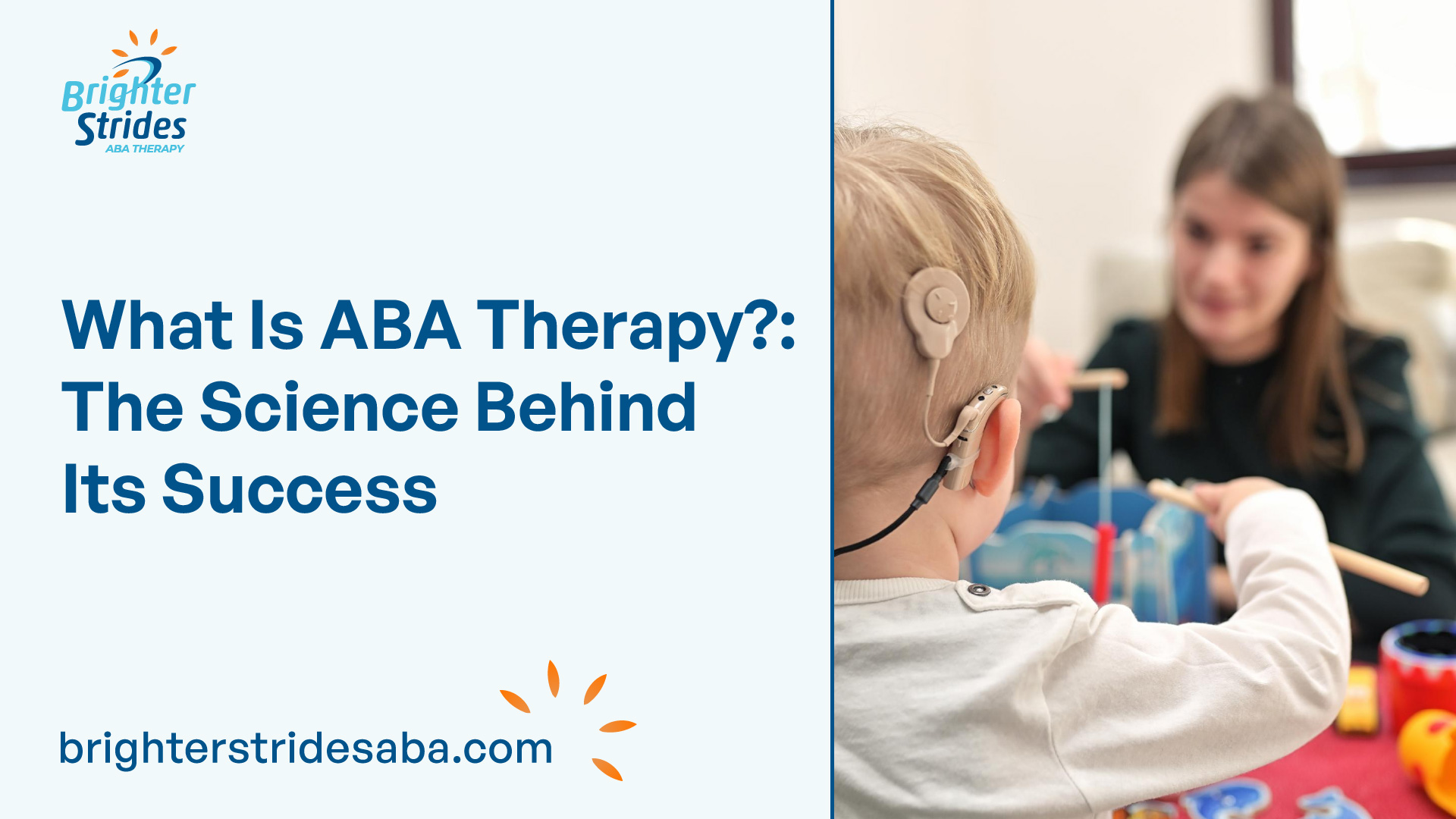Understanding ABA Therapy
ABA Therapy or Applied Behavior Analysis Therapy, is an evidence-based approach used to treat individuals with Autism Spectrum Disorder (ASD). It is widely recognized as one of the most effective treatments for autism.
ABA therapy focuses on understanding and modifying behavior by applying principles of learning theory.

What is ABA Therapy?
ABA therapy is a structured and individualized approach to help individuals with autism develop important skills and reduce challenging behaviors. It involves breaking down complex skills into smaller, more manageable steps and using positive reinforcement to teach and reinforce desired behaviors.
The goal of ABA therapy is to improve socially significant behaviors, such as communication, social skills, adaptive skills, and academic performance. It also aims to reduce behaviors that may interfere with daily functioning and learning, such as self-injury, aggression, and repetitive behaviors.
The Science Behind ABA Therapy
ABA therapy is rooted in the principles of behavior analysis, which is the scientific study of behavior. It is based on the understanding that behavior is influenced by the environment and can be modified through systematic interventions.
Key principles of behavior analysis that form the foundation of ABA therapy include:
- Antecedent-Behavior-Consequence (ABC) Model: This model emphasizes the relationship between antecedents (events or circumstances that occur before a behavior), behaviors (observable actions or responses), and consequences (events or outcomes that follow a behavior). By understanding these relationships, ABA therapists can identify the factors that influence behavior and develop effective interventions.
- Reinforcement: ABA therapy relies on the use of positive reinforcement to strengthen desired behaviors. Reinforcement involves providing rewards or incentives immediately following a desired behavior, which increases the likelihood of that behavior occurring again in the future. Reinforcement can be in the form of praise, tokens, treats, or access to preferred activities.
- Prompting and Prompt Fading: Prompting is a technique used in ABA therapy to assist individuals in performing a desired behavior. Prompting can be physical, verbal, or gestural cues that guide the individual towards the correct response. Over time, prompts are gradually faded to promote independent performance of the behavior.
- Task Analysis and Chaining: ABA therapy often involves breaking down complex skills or tasks into smaller, more manageable steps. This process is called task analysis. Once the steps are identified, they are taught individually and then linked together through a process called chaining. Chaining involves teaching each step in a sequence until the entire skill is learned.
ABA therapy is a dynamic and data-driven approach. Data collection and analysis play a crucial role in monitoring progress, making data-based decisions, and modifying interventions as needed. By tracking behavior and analyzing data, ABA therapists can objectively measure progress, identify patterns, and make necessary adjustments to optimize treatment outcomes.
Understanding the principles and science behind ABA therapy provides a solid foundation for comprehending its effectiveness and its potential to improve the lives of individuals with autism. Through the application of evidence-based strategies, ABA therapy helps individuals develop essential skills, reduce challenging behaviors, and enhance their overall quality of life.
Core Principles of ABA Therapy
ABA Therapy, or Applied Behavior Analysis Therapy, is guided by core principles that form the foundation of its effectiveness in helping individuals with autism. These principles include Applied Behavior Analysis, Individualized Treatment Plans, and Data Collection and Analysis.
Applied Behavior Analysis
Applied Behavior Analysis (ABA) is a scientific approach that focuses on understanding and modifying behavior. It involves analyzing the relationship between an individual’s behavior and the environment in which it occurs. ABA therapists use this approach to identify the factors that contribute to challenging behaviors and develop strategies to promote positive behavior change.
ABA utilizes various evidence-based techniques and interventions to address specific behavioral goals. It emphasizes the importance of breaking down complex skills into smaller, manageable components, making it easier for individuals with autism to learn and acquire new skills.
Individualized Treatment Plans
ABA Therapy recognizes that each individual with autism is unique, with their own strengths, challenges, and specific needs. As such, individualized treatment plans are a core principle of ABA Therapy. These plans are tailored to meet the specific goals and objectives of each individual, taking into account their age, abilities, and areas of need.
Individualized treatment plans are developed collaboratively, involving input from the individual, their family, and the ABA therapist. The plans outline the targeted behaviors for intervention, the strategies to be implemented, and the expected outcomes. Regular assessments and ongoing evaluation allow for adjustments to the treatment plan as necessary, ensuring that it remains responsive to the individual’s progress and evolving needs.
Data Collection and Analysis
Data Collection and Analysis are integral components of ABA Therapy. ABA therapists systematically collect data to track the individual’s progress and evaluate the effectiveness of the interventions being implemented. This data-driven approach allows for objective measurement and analysis of behavior change over time.
Data collection methods can include direct observation, checklists, and other measurement tools. The data collected is then analyzed to identify patterns, trends, and areas of progress or challenges. This analysis informs decision-making, allowing the ABA therapist to make data-informed adjustments to the treatment plan and interventions.
By adhering to the core principles of Applied Behavior Analysis, ABA Therapy provides individuals with autism a structured and effective framework for behavior modification and skill development. The individualized approach and data-driven nature of ABA Therapy ensure that interventions are tailored to meet the unique needs of each individual, maximizing their potential for positive outcomes.
Techniques Used in ABA Therapy
ABA therapy employs various techniques to effectively address the needs of individuals with autism. These techniques are designed to promote positive behavior change, skill development, and independence. Let’s explore Three Key Techniques commonly used in ABA Therapy:
- Positive Reinforcement
- Prompting and Prompt Fading
- Task Analysis and Chaining
Positive Reinforcement
Positive Reinforcement is a fundamental technique used in ABA therapy. It involves providing rewards or incentives to increase the occurrence of desired behaviors. By reinforcing positive behaviors, individuals with autism are motivated to continue engaging in those behaviors.
In ABA therapy, positive reinforcement can take different forms, such as verbal praise, tokens, or tangible rewards. The choice of reinforcement depends on the individual’s preferences and what effectively motivates them. By consistently reinforcing desired behaviors, individuals with autism learn and generalize these behaviors across various settings.
Prompting and Prompt Fading
Prompting is another technique used in ABA therapy to facilitate skill acquisition. It involves providing cues or hints to help individuals initiate or complete a desired behavior. Prompts can be verbal, physical, or visual, depending on the specific needs and abilities of the individual.
As the individual becomes more proficient in the desired behavior, the prompts are gradually faded to promote independence. This process is known as prompt fading. By systematically reducing the prompts, individuals with autism learn to perform the behavior without external assistance, thereby promoting skill development and independence.
Task Analysis and Chaining
Task analysis and chaining are techniques used to break down complex skills into smaller, more manageable steps. This approach allows individuals with autism to learn and master each step before moving on to the next. Task analysis involves identifying the specific components of a skill, while chaining refers to the process of teaching and linking those steps together.
ABA therapists use task analysis and chaining to teach a wide range of skills, from simple daily routines to more complex tasks. By breaking down skills into smaller steps and providing systematic instruction, individuals with autism can learn and achieve success in different areas of their lives.
These techniques, along with other individualized strategies, contribute to the overall success of ABA therapy in addressing the unique needs of individuals with autism. The use of positive reinforcement, prompting and prompt fading, and task analysis and chaining helps individuals acquire new skills, improve behavior, and enhance their overall quality of life.
Applications of ABA Therapy
ABA therapy, or Applied Behavior Analysis therapy, is a comprehensive and evidence-based approach that can be applied to various areas of skill development and behavior modification.
Let’s explore some of the key applications of ABA therapy:
- Skill Development
- Behavior Reduction
- Generalization and Maintenance
Skill Development
One of the primary goals of ABA therapy is to help individuals with autism develop and enhance various skills. Through systematic and structured interventions, ABA therapists work with individuals to target specific areas of skill development. These skills can encompass a wide range of domains, including:
- Communication Skills: ABA therapy focuses on improving both verbal and non-verbal communication skills, such as expressive language, receptive language, and social communication.
- Social Skills: ABA therapy aims to teach individuals appropriate social interactions, turn-taking, sharing, making eye contact, and recognizing and responding to social cues.
- Academic Skills: ABA therapy can support the development of academic skills, including reading, writing, math, and problem-solving.
- Daily Living Skills: ABA therapy helps individuals acquire essential life skills, such as personal hygiene, self-care, meal preparation, and household chores.
Through the use of behavior analysis techniques, such as reinforcement and task analysis, ABA therapy provides individuals with the opportunity to acquire and generalize these skills across various settings.
Behavior Reduction
Another crucial aspect of ABA therapy is behavior reduction. ABA therapists work closely with individuals to identify and address challenging behaviors that may interfere with their daily functioning and social interactions. By utilizing evidence-based strategies, ABA therapy aims to reduce problem behaviors and replace them with more adaptive and appropriate alternatives.
Some common challenging behaviors that ABA therapy can help address include:
- Aggression
- Self-injurious behavior
- Non-compliance
- Tantrums
- Stereotypic behaviors
ABA therapists employ techniques such as functional behavior assessment, behavior intervention plans, and positive reinforcement to decrease problem behaviors and promote positive alternatives.
Generalization and Maintenance
ABA therapy recognizes the importance of generalization and maintenance of learned skills and behaviors. Generalization refers to the ability to apply learned skills across different settings, people, and situations. Maintenance focuses on ensuring that skills and behaviors continue to be demonstrated consistently over time.
ABA therapy employs strategies to promote generalization and maintenance, including:
- Teaching in Natural Environments: ABA therapists work with individuals in real-life settings, such as home, school, or community, to facilitate the transfer of skills to these environments.
- Varying Materials and Instructions: ABA therapists use a variety of materials and instructions to ensure that learned skills can be applied in different contexts.
- Caregiver and Teacher Involvement: ABA therapists collaborate with caregivers and teachers to reinforce and support the generalization and maintenance of skills and behaviors outside of therapy sessions.
By prioritizing generalization and maintenance, ABA therapy aims to ensure that individuals can independently and consistently demonstrate their acquired skills and behaviors in various real-world situations.
Overall, ABA therapy offers a comprehensive approach to skill development, behavior reduction, and generalization and maintenance. By tailoring interventions to meet individual needs, ABA therapy empowers individuals with autism to reach their full potential and lead more independent and fulfilling lives.
The Success of ABA Therapy
ABA therapy has proven to be highly successful in helping individuals with autism spectrum disorder (ASD) develop essential skills and reduce challenging behaviors. The success of ABA therapy can be attributed to research and evidence-based practice, real-life success stories, as well as addressing criticisms and misconceptions.
Research and Evidence-Based Practice
ABA therapy is grounded in research and evidence-based practice, making it a widely recognized and effective treatment for individuals with autism. Numerous studies have demonstrated the positive outcomes of ABA therapy in improving communication skills, social interactions, and adaptive behaviors.
A comprehensive review of research studies conducted by the National Autism Center found strong evidence supporting the effectiveness of ABA therapy. The study reported that children who received early intensive behavioral intervention based on the principles of ABA showed significant improvements in cognitive, language, and daily living skills compared to those who did not receive such intervention.
Real-Life Success Stories
Real-life success stories of individuals who have undergone ABA therapy further highlight its efficacy. These stories showcase the significant progress and positive impact that ABA therapy can have on individuals with autism and their families.
Through ABA therapy, individuals with autism can experience improvements in their ability to communicate, engage in social interactions, and acquire essential life skills. The structured and individualized nature of ABA therapy allows for tailored interventions that target specific behaviors and goals, leading to meaningful and lasting outcomes.
Criticisms and Misconceptions
While ABA therapy has a strong research base and success stories, it is not without criticisms and misconceptions. Some critics argue that ABA therapy focuses too heavily on behavior modification and compliance, potentially overlooking the emotional needs and individuality of individuals with autism. However, it is important to note that ABA therapists strive to strike a balance between behavior modification and addressing the unique needs and preferences of each individual.
Critics also raise concerns about the intensity and duration of ABA therapy. It is essential to remember that the intensity and duration of therapy should be determined based on the individual’s needs and can vary. ABA therapy can be delivered in different formats, ranging from intensive early intervention programs to ongoing support and maintenance.
Addressing misconceptions surrounding ABA therapy is crucial to fostering a better understanding of its benefits and limitations. Ongoing dialogue and collaboration between professionals, individuals with autism, and their families can help ensure that ABA therapy continues to evolve and improve.
In summary, the success of ABA therapy stems from its research-backed foundation, real-life success stories, and the ongoing effort to address criticisms and misconceptions. By combining evidence-based practices with individualized treatment plans, ABA therapy provides individuals with autism the opportunity to thrive and reach their full potential.
Conclusion
ABA therapy is a comprehensive and evidence-based approach that has proven to be highly successful in helping individuals with autism spectrum disorder develop essential skills and reduce challenging behaviors.
Through techniques such as positive reinforcement, prompting and prompt fading, and task analysis and chaining, ABA therapists work closely with individuals to identify and address specific areas of skill development. By prioritizing generalization and maintenance, ABA therapy ensures that individuals can independently demonstrate their acquired skills across various real-world situations.
While criticisms and misconceptions surrounding ABA therapy exist, ongoing dialogue between professionals, individuals with autism, and their families can help ensure that ABA therapy continues to evolve and improve.
The success of ABA therapy stems from its research-backed foundation, real-life success stories, individualized treatment plans, and the effort to address criticisms.
ABA Therapy provides individuals with autism a structured framework for behavior modification and skill development through individualized interventions based on core principles of Applied Behavior Analysis.
With a data-driven approach to track progress objectively over time, ABA Therapy empowers individuals with autism to reach their full potential by promoting positive behavior change, skill development, independence while reducing challenging behaviors.
Sources
- https://www.nationalautismcenter.org/national-standards-project/results-reports/
- https://www.apa.org/science/about/psa/2017/06/applied-behavior-analysis.aspx
- https://www.autismspeaks.org/applied-behavior-analysis-aba-0
- https://www.bacb.com/about/




